Future Challenges and the Need for Seed Research in Food Security
Eshita Kundu and Sanjoy Kumar Bordolui
Volume-2, Issue-1, Jan.-Dec., 2025 2(1): 77-86(2025)
INTRODUCTION
Food security is the measure of the availability of food and individuals’ ability to access it. It has a strong correlation with socioeconomic level, disposable income, and household resources. Other challenges like food pricing, the changing global climate, water, energy, and the expansion of agriculture are also closely related to it.
The most important input for agricultural production is seed, with high-quality seed, one can boost yield without significantly expanding the area under cultivation. The establishment, growth, diversification, and enhancement of crop output have all relied heavily on seeds. One of the main agricultural inputs and a channel for introducing new technologies to farmers is seed. They have been the main factor in the distribution of plant populations over time and geography.
Definition:
Definitions of food and seed security appear quite similar. Two widely-cited definitions, both from the FAO are,
Food security:
“All people, at all times, have physical and economic access to sufficient, safe, and nutritious food to meet their dietary needs and food preferences for an active and healthy life” (FAO, 1998).
Seed security:
“Farming households (men and women) having access to adequate quantities of quality seeds and plant materials of adapted varieties at all times – good and bad” (FAO, 1998). These definitions illustrate the lack of universality, accessibility, adequate quantity, and suitable quality. Additionally, they outline ideal circumstances (Maxwell et al., 2008) and contend that concepts of vulnerability and coping with insecurity are part of the definition of food security. As a result, the definitions given above may be more helpful for outlining rights (FAO, 2005) than for identifying potential security flaws. (McGuire and Sperling 2014).
Objectives:
To increase wheat, rice, and pulse productivity and production in a sustainable manner.
To increase farmers’ incomes by implementing improved farm management techniques and technologies.
To guarantee the nation’s food security.
Food and Seed Security Frameworks:
These dimensions of food security are:
-Food availability:
People, especially the impoverished, should have access to adequate amounts of food of suitable quality, either through domestic production or imports (including food aid).
-Food access:
It also highlights the fact that food security is a dynamic term, meaning that people’s access to sufficient resources (entitlements) for purchasing the right foods for a healthy diet must remain constant throughout time.
-Utilization:
In order to achieve a state of nutritional well-being when all physiological needs are satisfied, food must be used through a sufficient diet, clean water, sanitation, and medical attention. This highlights how crucial non-food inputs are to food security.
-Stability:
A population, household, or individual must always have access to enough food in order to be considered food secure. They shouldn’t take the chance of losing access to food due to cyclical occurrences (like seasonal food insecurity) or abrupt shocks (like an economic or climatic disaster). Therefore, the availability and access aspects of food security can also be referred to as stability.
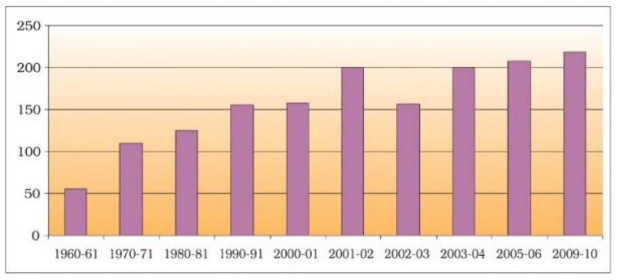
Fig. 1.
Production of Food grains in India (Million Tonnes) (Source: Economic Survey, 2011-12).
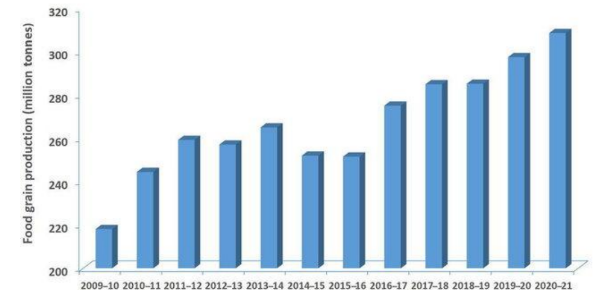
Fig. 2.
Total food grain production trend in India during 2009–2010 and 2020–2021. (Source: Ministry of Agriculture & Farmers’ Welfare, Government of India)
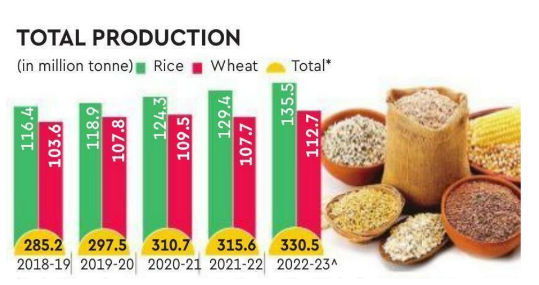
Fig. 3.
https://beyondindia.in/india-achieves-record-high-food-grain-production-in-2022-23/#google_vignette
These dimensions of seed security are:
Seed security:
It prevails when both men and women in the household have adequate access to amounts of high-quality seed and planting materials of their favourite crop kinds throughout both good and bad cropping sessions
Seed Availability:
It is the state in which local farmers’ seed needs are met by a sufficient supply of seeds from various sources, including social networks, local marketplaces, the official seed industry, and seed aid suppliers (Bordolui et al., 2015). The farmer should be able to get the seed in time for sowing and it should be reasonably close.
Seed Access:
It exists when farmers can obtain seed via buying, borrowing, trading, bartering, or using their influence in social networks
Seed Varietal Suitability:
It is the available seeds of crop varieties that farmers favour based on a variety of desired attributes. Look, flavour, aroma, storability, fodder production potential, high revenue potential, high production potential, resistance to pests and diseases, and whether or not there is extraordinary resistance in the fields are some examples of the qualities. Farmers need seeds that they know people prefer and that they know will increase yield and benefit. Since utilizing improved seed varieties alone can enhance crop yields by 20–30%, seed quality is a crucial factor in agricultural progress.
Seed Quality:
in agricultural progress. ➢ Seed Quality: It includes the following technical factors: seed health, physical purity, varietal purity, and germination.
Resilience of the Seed System:
This is the seed system’s ability to withstand, adjust to, and recover from biotic (disease and pest) and abiotic (drought, floods, water logging, etc.) stressors and shocks that endanger household income, food and nutrition security, and livelihoods. In both good and bad cropping seasons, the entire seed system should help ensure that there is always ample availability to appropriate amounts of adapted and favoured seed (Abebe and Alemu 2017).
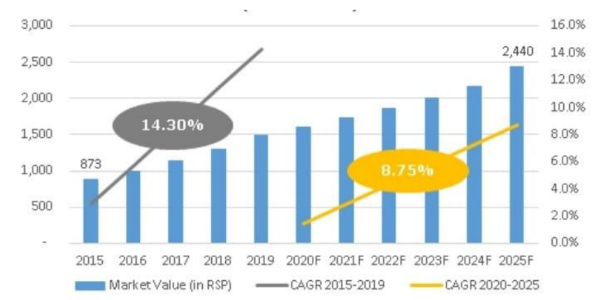
Fig. 4.
Seed market value in India. Note: RSP= Retail Selling Price (Source: https://www.wm-strategy.com/news/india-nuts-and-seeds-market-to-grow-at-cagr-of-8-75-until-2025)
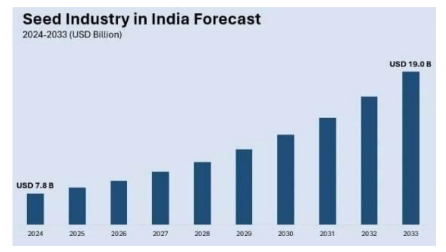
Fig. 5.
The size of the seed industry in India reached USD 7.8 Billion in 2024 and the market is projected to reach USD 19.0 Billion by 2023, exhibiting a growth rate (CAGR) of 10.5% during 2025-2033 (Source:https://www.imarcgroup.com/seed-industry-in-india).
Food Security- world scenario
As of 2024, 638-720 million people globally are estimated to be facing hunger. (FAO, IFAD, UNICEF, WFP and WHO, 2025).
Approximately 2.3 billion people suffer moderate or severe food insecurity. (FAO, 2025)
The cost of a healthy food is growing in many places due to supply chain shocks, inflation, and other factors, making it unaffordable for a significant section of the world’s population (FAO, IFAD, UNICEF, WFP and WHO, 2024).
Food Security in India
About 12% of India’s population is undernourished (172 million people). In terms of undernourishment, India still ranks seventh in Asia and 48th internationally, despite an improvement from 243 million in 2006.
A large share of people cannot afford a healthy diet. In India, ~42.9% of people cannot afford a healthy diet under current food price levels.
West Bengal Scenario
To improve food security, West Bengal has its own state-level initiatives. One significant program is “Khadya Sathi”, which covers over 8.5 crore (approximately 85 million) persons as of recent years.
That’s ~ 90% of the state’s population. Under this scheme, food grains (rice, wheat) are provided at ₹2 per kg (rice or wheat) or half the market price for certain categories.
SEED SUPPLY CHAIN
The supply chains for inputs are extremely intricate, extending from the Ministry of Agriculture to the national seed agency, which provides the foundation seed, and then passing via outgrowers, distributors, wholesalers, retailers, and frequently numerous other channels before the farmer plants the seed.
The picture illustrates how informal and formal seed systems interact to provide farmers with seeds. The same broad phases or processes that occur in the formal sector during seed production processing also occur in the local system: variety selection, testing, introduction, seed multiplication, selection, distribution, and storage (Bordolui et al., 2020). However, the informal system operates as a component of farmers’ production systems rather than as separate endeavours (Chand and Kc 2020).
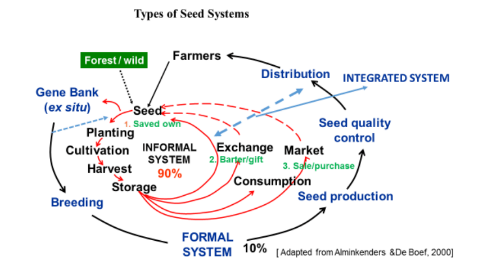
Fig. 6.
Types of seed systems, Formal, Informal and Integrated Seed System (Gauchan and Shrestha 2020)
WHAT IS HUNGER?
The UN’s Hunger Report states that the term “hunger” refers to times when people are severely food insecure, which means they go for days at a time without eating because they lack access to food, money, or other resources. Here are some widely accepted definitions:
-The discomfort brought on by a shortage of food is known as hunger. Less than 1,800 calories per day is the cutoff point for undernourishment, also known as food deprivation.
-Deficits in energy, protein, and/or vital vitamins and minerals are indicated under nutrition, which goes beyond calories.
-Undernutrition and overnutrition (issues with imbalanced diets) are both considered forms of malnutrition.
-The availability, accessibility, and use of food are all related to food security. A person is said to be food secure if they consistently have access to enough safe and nourishing food to sustain an active and healthy life.